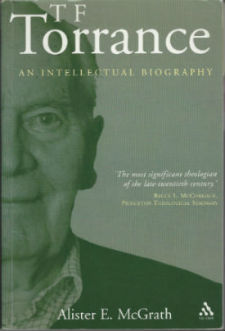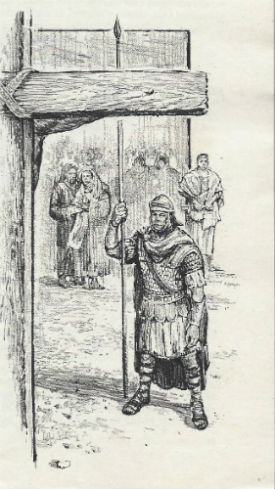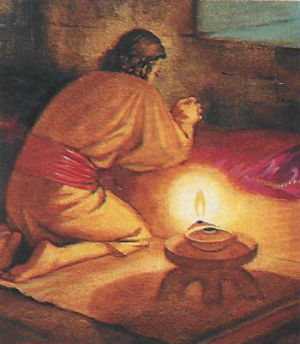 JEWISH HIGH PRIEST: Everything about this office pointed to Jesus the eternal, heavenly high priest.
JEWISH HIGH PRIEST: Everything about this office pointed to Jesus the eternal, heavenly high priest.By Neil Earle
 JEWISH HIGH PRIEST: Everything about this office pointed to Jesus the eternal, heavenly high priest.
JEWISH HIGH PRIEST: Everything about this office pointed to Jesus the eternal, heavenly high priest.The human Jesus was the eternal Word descending from the heavenly places to work out our salvation as High Priest and Intercessor. Theologian Thomas Torrance reminds us of how much was at stake in this event we call the Incarnation, when God became flesh for the suffering of death (Hebrews 2:12-14).
 Edinburgh theologian Thomas F. Torrance wrote eloquently about Jesus' obedient life and death as a perfect offering for sin and thus began the human race all over again.
Edinburgh theologian Thomas F. Torrance wrote eloquently about Jesus' obedient life and death as a perfect offering for sin and thus began the human race all over again.
Torrance in fact paints a vividly heroic portrait of all Jesus did for us while in the flesh.
“The Son of God become man is the strong man of Jesus’ own parable who invades the tyrant’s house and by his power subdues him, binds him, and spoils him of all that he has unjustly usurped (Matthew 12:29). But he enters the house of alienation and bondage under the power of evil and subdues the power of evil not by divine violence, but by obedience and steadfastness as a Son to the father’s holy will in the face of the attack of all the power of evil; and so he overcomes by patience and passion and sheer faithfulness and holiness and love, by living out perfectly within all the conditions of our humanity the obedience of the Son to the Father” (Torrance, Incarnation, 117-118).
This is a powerfully written and gripping way to put Jesus’ own struggle with sin for the writer of the Hebrews letter tells us he was “tempted in every way just like we are – yet without sin” (Hebrews 4:15).
This did not mean Jesus had a human nature like Saddam Hussein’s or Charles Manson but it does mean he was tested by the full gamut of human temptation. The implications are truly staggering, as Torrance adds:
 The crucifixion was neither defeat nor a punishment from God but the climax of Jesus' perfect self-offering for sin in his role as high priest and Second Adam.
The crucifixion was neither defeat nor a punishment from God but the climax of Jesus' perfect self-offering for sin in his role as high priest and Second Adam.
“Thus by taking our flesh on himself the Son of God exposed himself to the fearful assaults of Satan and evil and sin; he advanced to meet it at the very summit of its wickedness [on the cross], drew it all to himself and slew it as he submitted to the divine judgment upon it; he destroyed it as he was doing its worst in seeking to destroy him.” As Bishop N.T. Wright said “Jesus won by losing.” On the cross he seemed to have been defeated but his resurrection by the Father in the power of the Spirit was God’s supreme Exhibit A that sin and death would not have the last word on this planet (Ephesians 1:19-20), that even death cannot separate us from the love of God a(Romans 8:38-39). At death Christians depart to be with the Lord, as St. Paul explained (Philippians 1:23).
Torrance shows how Jesus penetrated into the very heart of our sinfulness where evil is enthroned. He defeated it by expiating guilt as humanity's perfect offering for sin and casting it behind him in many ways, most impressively by showing his love on the cross even for his executioners. He then went on to burst even the bonds of death asunder at his resurrection and ascension in the power of the Spirit.
God’s Plan could not be defeated through the spectacle of the crucifixion. Jesus as our representative human, the Second Adam 1 Corinthians 15:45) was the Instrument to qualify himself and all of us by his actions as the Great High Priest, nicely summarized in Hebrews 5:5-11.
Torrance explains that the Atonement was a two-way movement. (Torrance, Incarnation, 117-118).
Jesus descended to fulfill the covenant from our side of the equation by a life of obedience perfected through suffering – his perfect life given on the cross is his gift and sacrifice for sins (Hebrews 5:1)
From the human side he ascends to intercede for us as our perfect representative and make possible God’s loving kindness towards us repentant sinners (Hebrews 9:12).
 Jesus saw prayer as a life and death matter.
Jesus saw prayer as a life and death matter.
Hebrews 5 mentions the human Jesus crying out in prayer, with vehement cries and supplications. “It is in that light,” say Torrance, “that we are to see the prayer life of Jesus … not only in adoring God and hearing God, but calling upon him in utter reliance and dependence upon him, and in asking succor and strength from him. This is priestly prayer, intercession with God.”
Let’s review these powerful concepts with Hebrews 5 in mind:
1. There is a spirit of disobedience worldwide (Ephesians 2:2) and Jesus not only resisted that spirit he decisively defeated its emissary, Satan the Devil, in the Wilderness testing.
2. Jesus became our Champion, fought our battles for us. He rebuked Satan: “You shall not tempt the Lord your God,” and gave this despicable being a command, “Away with you Satan” (Matthew 4:10). And Satan slunk away.
 THE PINNACLE OF THE TEMPLE: Here Jesus met the second great test from Satan – refusing to "show off" his God powers (Matthew 4:5-7).
THE PINNACLE OF THE TEMPLE: Here Jesus met the second great test from Satan – refusing to "show off" his God powers (Matthew 4:5-7).
3. Jesus qualified us along with himself by taking our human nature upon him and triumphing over it (Colossians 1:12). Unlike us, says Torrance, “He cast himself in utter reliance upon God the Father, in utter dependence upon his will…” and won the victory through humility. As heavenly High Priest he is our representative before the Father in heaven. Symbolically speaking, when he ascended he took us with him to the heavenly places (Ephesians 2:8). We are symbolically “covered” in his priestly work.
4. Jesus’ prayer in Gethsemane epitomized his whole life as a sweet offering ascending Godwards from a planet in rebellion, a prayer exemplifying perfect submission: “Not my will (that is the will of the alienated humanity which Jesus has made his own), but thy will be done” (Luke 22:42).”
5. Thus Jesus not only repelled the assaults of darkness but made the perfect self-offering of man to God. He was not punished by God; He willingly suffered in our stead. Being God in the flesh His sacrifice had cosmic significance: “It is here in Jesus Christ, in this worshipping and praying obedience that all creation is turned and brought back to God the Creator…” See 2 Corinthians 5:14 – when God died on the cross we all died, cosmically; but when he was raised he took us with him as well. The tragedy is the human race does not know this yet, but one day they will. At the name of Jesus every knee shall bow – even the hopelessly rebellious (Romans 14:11).
6. God the Father confirmed Jesus’ victorious high priesthood by raising him from the dead in the power of the Spirit (Hebrews 9:14). At that time our fellowship with the Father was sealed, says Torrance, “beyond all assaults of evil and any possibility of undoing. “
As the song says, “that’s why we praise him/that’s why we sing…cause he gave his everything.” What a great High Priest we serve!